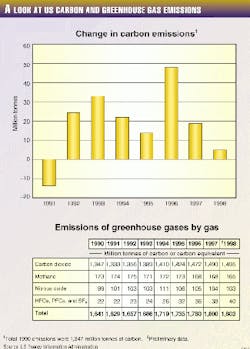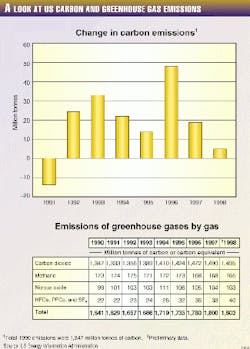US greenhouse gas emissions growth slows
Growth in US emissions of greenhouse gases is slowing, and voluntary efforts by industry-especially the energy industry-appears to be a significant factor in that trend.
In 1998, US emissions of greenhouse gases-mostly consisting of carbon dioxide-increased by 0.2% vs. those measured in 1997, marking the lowest annual growth rate since the US economic recession of 1991 (see chart).
Total emissions, meanwhile, were about 10% higher vs. 1990 findings, according to one of the latest studies on the subject conducted by the US Energy Information Administration.
The slowed growth of greenhouse gas emissions may be attributable, at least in part, to an increase in the number of planned or existing projects that claimed reductions or offsets of greenhouse gas emissions in 1998. Such emission-reducing projects were reported to the EIA by 187 US companies and other organizations through a voluntary reporting program, the agency said.
Slowed growth
Carbon dioxide constitutes about 83% of US greenhouse gas emissions, says EIA. In addition, about 98% of CO2 emissions is attributable to the combustion of fossil fuels. In 1998, says EIA, these emissions increased by 0.3%, or 5.1 million tonnes of carbon.
CO2 emissions from all sources totaled 1.496 billion tonnes of carbon last year, according to EIA.
The agency said, "Significantly warmer-than-usual weather in the US reduced consumption of winter heating fuels and resulted in emissions from the residential and commercial sectors being essentially unchanged in 1998."
A decline of 1.3% was seen in emissions from the industrial sector-concentrated mainly in the petroleum, refining, chemical, and primary metals industries-despite the US economy growing 3.9% in 1998.
Excluding CO2, emissions of other greenhouse gases declined by 0.6% to 308 million tonnes of carbon equivalent (tce), says EIA.
(EIA converts emissions of greenhouse gases other than carbon dioxide into "carbon-equivalent tonnes" using 100-year global warming potentials [GWPs], similar to the practice of the Intergovernmental Panel on Climate Change. Intended to offer a gauge of the comparative effect of a certain range of greenhouse gases on climate, GWPs assist in making comparisons possible across various gases.)
Other information provided in the EIA study details various gases and their sources. These include methane, nitogen oxides, and other manmade gases.
Methane emissions-the second largest contributor of total greenhouse gas emissions-fell by 1.5% in 1998, accounting for 9% of GWP-weighted emissions. In fact, since 1990, US methane emissions have fallen by about 4.5%. The chief reason behind this decline, says EIA, was the increased capture of gas from landfills, following new US Environmental Protection Agency regulations.
While accounting for about 6% of total greenhouse gas emissions, nitrogen oxide emissions have also decreased in 1998 to 103.1 million tce.
Manmade emissions-such as hydrofluorocarbons, perfluorocarbons, and sulfur hexafluoride-make up about 2% of total US greenhouse gas emissions. Emissions of these gases increased to 39.5 million tce from 38.4 million tce.
Voluntary reporting
According to figures compiled through its voluntary reporting program, as mandated by the Energy Policies Act of 1992, EIA says that 1,507 projects claimed reductions or offsets of greenhouse gas emissions in 1998 of 212 million tce.
This figure is about 3.2% of total US emissions for the year. Only one third of this amount-about 74 million tce-was reported in 1994, the first year of the voluntary program, says EIA.
The electric power sector accocunted for the bulk of the volunteers, with 105 companies reporting to the EIA. Among the projects reported were plant efficiency improvements; use of cogeneration; use of nonfossil fuels, such as nuclear and renewable fuels; demand-side management programs that reduced power use; landfill methane-recovery projects; urban forestry; and tree-planting projects.
Firms reporting to EIA outside of the power sector have grown six-fold since the agency began the program. The companies include firms involved in automobile manufacturing, petroleum production and refining, coal mining, chemicals, metals, health care, pharmaceuticals, food, home furnishings, and electronic equipment.

